A large-scale Russian air assault struck Kyiv, Ukraine’s capital, resulting in the deaths of at least 10 people, according to local officials. The attack, described as “massive,” targeted multiple sites across the city, escalating tensions amid the ongoing conflict between Russia and Ukraine. This latest strike highlights the growing intensity of hostilities as Ukrainian authorities and international observers condemn the assault.
Massive Russian Air Assault Strikes Kyiv Resulting in Significant Casualties
In a devastating turn of events, multiple air strikes targeted key areas of Kyiv, inflicting severe damage and resulting in at least 10 confirmed fatalities. Witnesses reported a series of explosions ripping through residential neighborhoods during the early hours, forcing residents into bomb shelters and causing widespread panic. Emergency services rushed to the scenes amid reports of collapsed buildings and numerous injuries.
The attacks have sparked urgent international condemnation, with several governments calling for immediate humanitarian aid and a ceasefire. Key details of the assault include:
- Number of air raids: Over a dozen sorties launched within three hours
- Targeted zones: Residential complexes, critical infrastructure, and transportation hubs
- Emergency response: Over 50 injured treated in local hospitals
- Communication:** Kyiv’s mayor declared a state of emergency to better coordinate rescue efforts
| Metric | Data |
|---|---|
| Fatalities | 10+ |
| Injuries | 50+ |
| Flights Conducted | 12+ |
| Areas Affected | 5 key districts |
Strategic Implications of Continued Attacks on Ukraine’s Capital
The persistent Russian strikes on Kyiv signal a deliberate escalation aimed at undermining Ukraine’s political resolve and disrupting vital civilian infrastructure. By targeting the capital, Moscow seeks to sow fear, destabilize local governance, and erode public morale, while compelling Kyiv to divert military resources to home defense rather than front-line engagements. This tactic reflects a broader shift in Russian strategy, prioritizing psychological and infrastructural damage over purely territorial gains.
Key strategic ramifications include:
- Heightened risk of civilian casualties, impacting international support dynamics.
- Intensified strain on Ukraine’s emergency response and humanitarian systems.
- Potential disruption of diplomatic negotiations due to escalated hostilities.
- Greater likelihood of expanded Western military aid, as pressure mounts to defend critical urban centers.
| Impact Area | Short-term Effect | Long-term Consequence |
|---|---|---|
| Infrastructure | Power outages, transport delays | Reconstruction challenges, economic burden |
| Civilian Morale | Fear and displacement | Potential social fragmentation |
| Military Deployment | Reallocation of forces | Reduced offensive capabilities |
Recommendations for Enhancing Kyiv’s Defensive and Civilian Protection Measures
To strengthen Kyiv’s resilience against recurring missile strikes, it is crucial to upgrade the city’s early warning systems. Integrating AI-powered radar detection alongside existing frameworks can drastically reduce response times, allowing more effective deployment of air defenses. Additionally, expanding the city’s network of mobile air defense units with modernized surface-to-air missile systems can improve interception rates, safeguarding both military assets and civilian zones. Investment in these technologies must be prioritized to adapt to evolving threats swiftly.
Civilian protection measures should be reinforced through improved community shelters and optimized evacuation protocols. Enhancing public awareness campaigns with multilingual emergency broadcasts and real-time updates via mobile apps will enable residents to make informed decisions during air raids. Moreover, local authorities can benefit from establishing a centralized crisis management hub that coordinates artificial intelligence analytics and ground-level intelligence to streamline resource allocation. The table below outlines key recommendations along with their potential impact on Kyiv’s defense and civilian safety:
| Recommendation | Expected Outcome | Priority Level |
|---|---|---|
| AI-Enhanced Early Warning Systems | Reduced response time to missile threats | High |
| Deployment of Mobile Air Defense Units | Increased missile interception rates | High |
| Upgraded Civilian Shelters | Improved civilian survival and comfort | Medium |
| Multilingual Emergency Communication | Better emergency preparedness among residents | Medium |
| Centralized Crisis Management Hub | Efficient resource allocation | High |
Future Outlook
The devastating air assault on Kyiv marks a grim escalation in the ongoing conflict, underscoring the persistent threat to civilian areas amid mounting tensions. As investigations continue and casualties rise, the international community watches closely, calling for renewed efforts toward de-escalation and humanitarian aid. The full impact of the attack remains to be assessed, but the tragic loss of life highlights the urgent need for dialogue and resolution in the region.
















